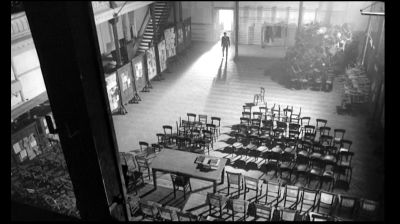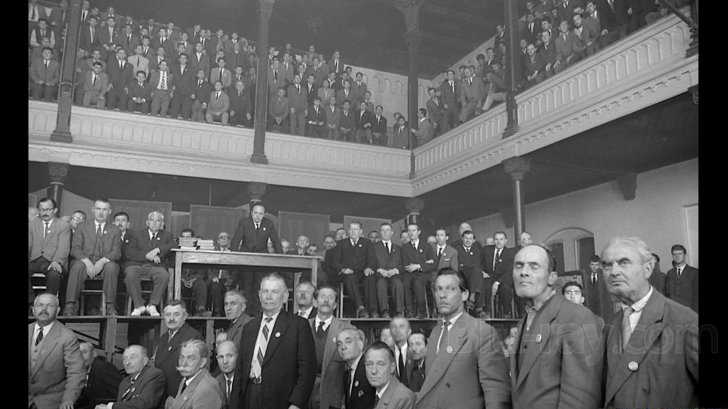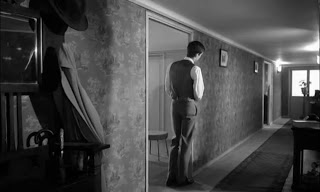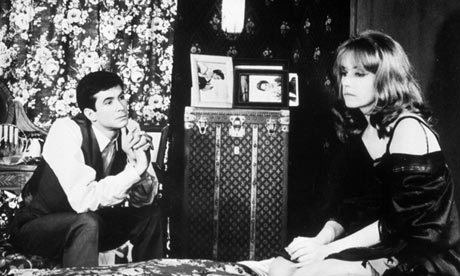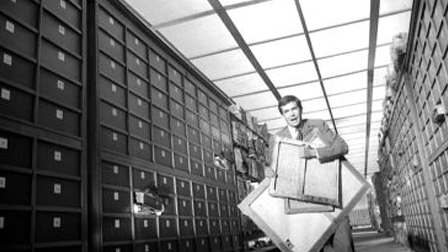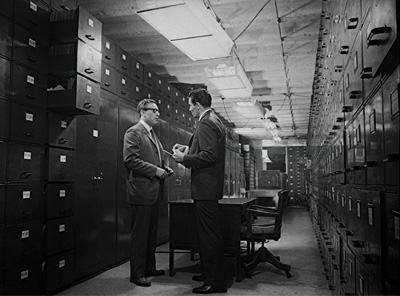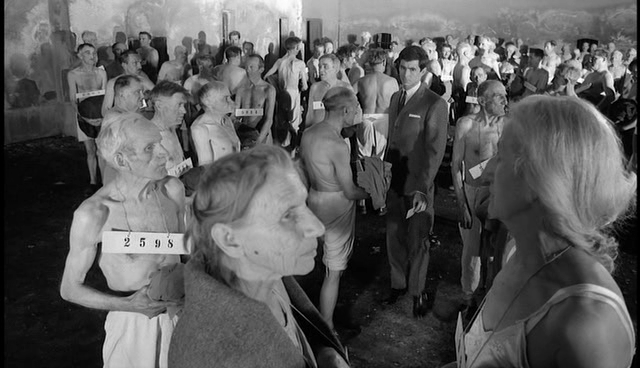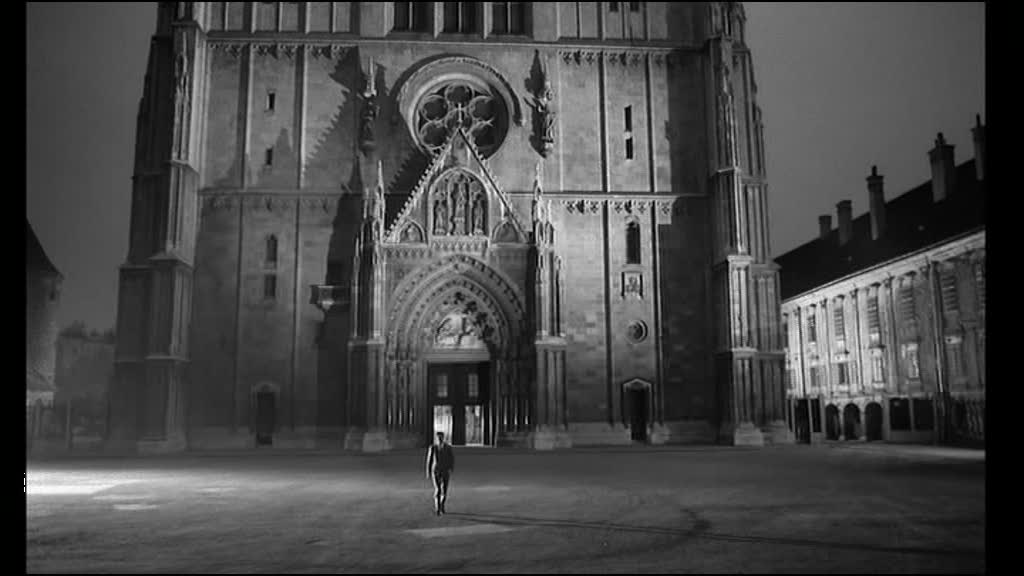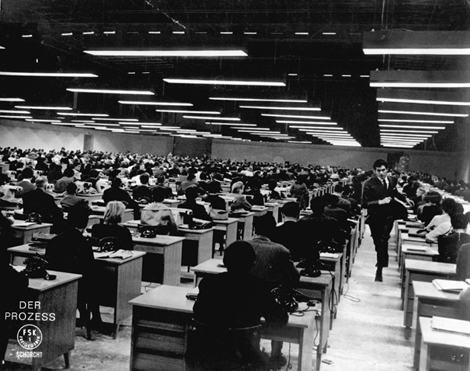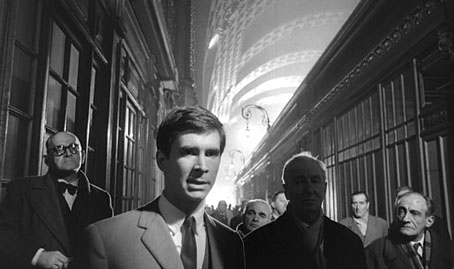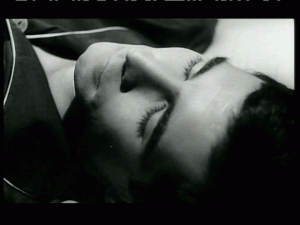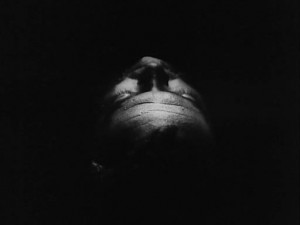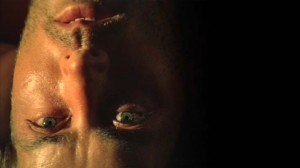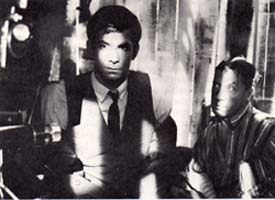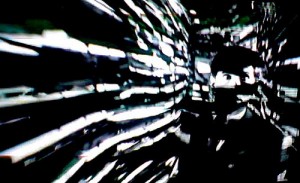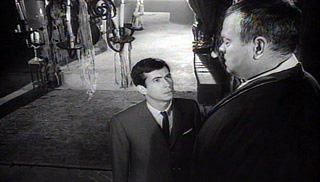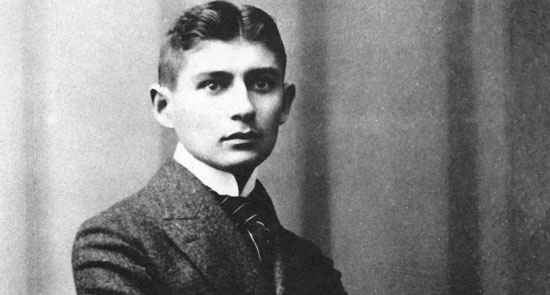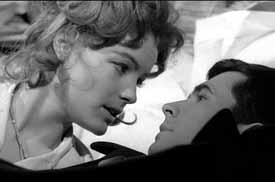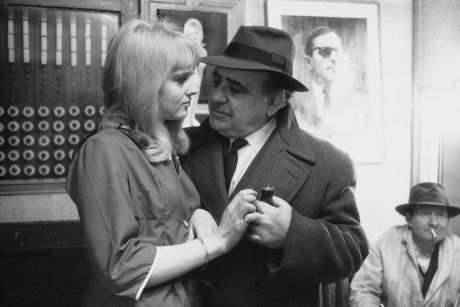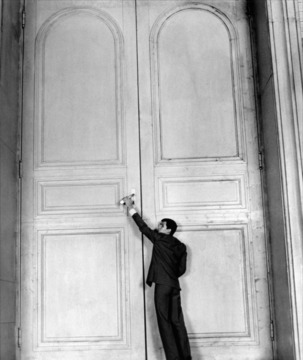Written for the StudioCanal Blu-Ray of The Trial in the Spring of 2012. — J.R.
‘What made it possible for me to make the picture,’ Orson Welles told Peter Bogdanovich of his most troubling film, ‘is that I’ve had recurring nightmares of guilt all my life: I’m in prison and I don’t know why –- going to be tried and I don’t know why. It’s very personal for me. A very personal expression, and it’s not all true that I’m off in some foreign world that has no application to myself; it’s the most autobiographical movie that I’ve ever made, the only one that’s really close to me. And just because it doesn’t speak in a Middle Western accent doesn’t mean a damn thing. It’s much closer to my own feelings about everything than any other picture I’ve ever made.’
To anchor these feelings in one part of Welles’ life, he was 15 when his alcoholic father died of heart and kidney failure, and Welles admitted to his friend and biographer Barbara Leaming that he always felt responsible for that death. He’d followed the advice of his surrogate parents, Roger and Hortense Hill, in refusing to see Richard Welles until he sobered up, and ‘that was the last I ever saw of him….I’ve always thought I killed him….I don’t want to forgive myself. That’s why I hate psychoanalysis. I think if you’re guilty of something you should live with it.’
On the other hand, as Welles fully acknowledged on other occasions, his temperament and background were quite different from Kafka’s. The world of Franz Kafka (1883-1924), ruled by male tyrants who make arbitrary decisions, clearly had something to do with his own domineering father in a middle-class Jewish household in turn-of-the-century Prague, whereas Welles, born the year after The Trial was written, grew up in much more privileged surroundings in the American Midwest with a strong, disciplinarian mother and a soft, permissive father, a couple who separated by mutual agreement when he was only six — circumstances reflected in various ways in both Citizen Kane and The Magnificent Ambersons. So even though Welles retained a surprising amount of Kafka’s scenes and dialogue in one form or another in his film, it can’t be said to qualify as a close adaptation, unlike his versions of either The Magnificent Ambersons or The Immortal Story. Considering the fact that the novel remains rough and unfinished — even though, unlike the earlier The Man Who Disappeared (retitled Amerika by Kafka’s friend and literary executor Max Brod) and the later The Castle, its author had given it a clearly defined conclusion — it offers far more choices to the adapter than any completed narrative would. So it’s understandable that Welles would combine two of Kafka’s characters — a waitress and prostitute named Elsa whom Josef K. visits every week (although she barely figures in the story’s action) and Fraülein Bürstner, a typist who lives in the room next to his –- and, casting Jeanne Moreau in this part and calling her Miss Burnster, would produce a character unlike either of Kafka’s sketchy figures and arguably somewhat nearer in her bossy temperament to Touch of Evil’s Tanya (Marlene Dietrich).
Closer in some ways as an adaptation to Welles’s unfinished Don Quixote (especially if one considers it in isolation from Jesus Franco’s dubious and dull ‘completion’ of that work, which edits in large portions of a hack documentary about Spain while leaving out many of Welles’s best scenes), The Trial (1962) emerges as a highly personal and slanted reading of a classic that adapts it to Welles’ own twisted times — which, all proportions guarded, also makes it comparable to his legendary 1937 stage production of Julius Caesar in contemporary Fascist regalia, his even more famously updated 1938 War of the Worlds for radio, or his elaborately planned but never filmed first Hollywood feature, Heart of Darkness, which years later would inspire Coppola’s Apocalypse Now. More nightmarish and unsettling in many respects than any of these, The Trial has a sense of hallucinatory horror while confronting the corruptions and self-deceptions of the contemporary world that comes even closer to Welles’ previous feature and final Hollywood studio production, Touch of Evil (1958) — recalled here in both the humiliations undergone by Akim Tamiroff’s character and in the near-replication of the earlier film’s Hall of Records in a contemporary library of file cabinets (presided over by Paola Mori, Welles’ wife). (Conversely, the creepy visit to Titorelli’s cramped studio recalls both the slatted bathhouse in Othello and Michael Redgrave’s antique shop in Arkadin.)
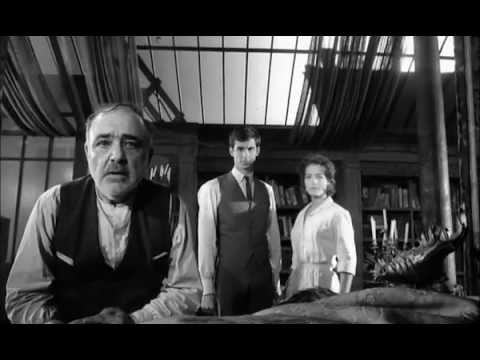
Described in Welles’s opening narration as a film with ‘the logic of a
dream…of a nightmare,’ it’s plainly a film designed to freak us out,
and it had precisely that effect on me in my late teens, when it first
came out. But, unlike most of Welles’s other films, it’s an experience
to be undergone and felt more than thought about in very much detail.
I suspect that Welles arrived at this conclusion himself when he chose
to omit his satirical reflections about computers regarded as fortune-
tellers — in a scene with Katina Paxinou that survives without sound,
and has been subtitled with its scripted dialogue for this release as an
extra. Bogdanovich admitted to Welles that The Trial was the only
picture of his that he didn’t warm to — a judgment he subsequently
revised after attending a screening with Welles himself, whose
laughter convinced him that the film was much funnier than he had
realized. (It’s worth recalling, for those who might find this perverse,
that Max Brod wrote in his biography of Kafka, ‘We friends of
[Kafka] laughed quite immoderately when he first let us hear the
first chapter of The Trial. And he himself laughed so much that
there were moments when he couldn’t read any further.’)
Whether or not we laugh much during Welles’ version of The Trial,
it has never found a very secure and comfortable place within his
oeuvre, perhaps because it qualifies in some ways as a commissioned
work. (When Alexander and Michael Salkind proposed producing a
film of his in France, he said he would have preferred directing one of
his own stories, but had to select from a list of literary classics believed
to have been in the public domain.) It proved to be his only completed
film adapted from a literary source not in English, and the difficulty we
have in locating its action both geographically as well as historically —
and more specifically, in accepting Anthony Perkins as a bureaucrat in
an Eastern European city with a European uncle and cousin, arrested
by cops with American accents, or in adjusting to an updating of the
story by almost half a century — has continued to inflect our responses.
Such changes inevitably led to others (spoilers ahead): for Kafka’s
original ending of K. letting himself be stabbed in the heart and
dying “like a dog,” Welles felt obliged in a post-Holocaust world to
have him defy his executioners. And even after retaining most of
Kafka’s scenes and much of his dialogue, Welles made additions to
both in order to incorporate details involving war refugees and
computers (though the resemblance of an explosion at the end to a
mushroom cloud, by his account, was both accidental and
unfortunate).
And yet certain key artifacts of the mid-20th century are just as
pointedly omitted, such as TV sets. Speaking with an audience of
students and film buffs about The Trial at the University of Southern
California on November 14, 1981 –- a session filmed but never edited
for possible use in a documentary, Filming The Trial, conceived as
a companion piece to Welles’ Filming Othello (1979) — Welles said,
‘In my reading of the book — and my reading is probably more wrong
than a lot of people’s — I see the monstrous bureaucracy which is the
villain of the piece as not only Kafka’s clairvoyant view of the future,
but his racial and cultural background of being occupied by the
Austro-Hungarian Empire….[So] I wanted a 19th century look for a
great deal of what would be, in fact, expressionistic.’ In short, one
might say that Welles wanted to superimpose Kafka’s inherited past
over his future rather than settle for any ordinary version of his and
our present.
Conceptually, Welles also had to alter his own plans to film in elaborately
designed studio sets in Zagreb that would gradually disappear over the
course of the story, “flying away into the darkness,” once budgetary
vicissitudes suddenly made this scheme impossible. (The only locations
Welles originally planned to use were the huge office where K. works and
the streets of Prague and Zagreb at the end where K. is led to his
execution.) His main replacement for these sets proved to be various
parts of Paris’s Gare d’Orsay, which he discovered one night from his
room at the Hôtel Meurice — a location that carried, as he described it
in a BBC interview, ‘a kind of Jules Verne modernism’.
…The thing that gave it a particular force is that it’s not only a very
large place to work in, and a very beautiful place to photograph,
but that it’s full of sorrow — the kind of sorrow that accumulates in
a railway station where people wait….And the story is all about
people waiting, waiting, waiting for their papers to be filled
…and it’s also a place [of] refugees. People were sent to Nazi
prisons from there. Algerians were gathered there….
This was the second time in Welles’ career as a European
independent that he had to forfeit his carefully planned set
designs: in Othello, (1951), a film which begins with a similar
shot (an upside down close-up of the hero with his eyes closed
— later imitated by Coppola to introduce Martin Sheen in
Apocalypse Now), he also had to devise a makeshift
patchwork editing style out of his ‘found’ international
locations, creating imaginary places out of diverse details,
after his budget for sets (and, in that case, costumes) had
evaporated — a methodology carried over to some extent in
Mr. Arkadin (1955), though arguably far more appropriate
here, to match Kafka’s own spatial discontinuities.
Coincidentally, 90-odd sheets of Welles’ annotated drawings
for his production designer on The Trial, Jean Mandaroux,
were put up for auction at Sotheby’s in 2012, while this essay
was being written, and the partial glimpses of these drawings
found on Sotheby’s web site confirm Welles’ remark to
\Bogdanovich that Titorelli’s studio and the similarly slatted
corridor where the little girls chase K. are the major parts of
the production design that remained in the film.
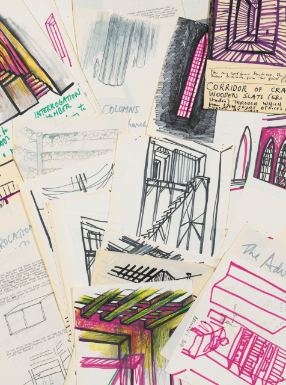
Franz Kafka’s second unfinished novel, written about a year
before Orson Welles was born and first published 11 years later,
in 1925, a year after its author’s death, has more than its share
of predatory, sexually aggressive women, but not ones who
come across as threateningly as those in Welles’ adaptation, set
almost half a century later. When Leni in the novel, seated in
K.’s lap, asks him if he has a sweetheart, he shows her a
snapshot of Elsa, but in the film we’re led to assume this must
be one of Fraülein Bürstner — even though there’s no indication
that she and K. have ever gone further than their few casual
kisses exchanged during their only long scene together.
Welles himself admitted that “the eroticism is dirty and morbid”
in the film, but it doesn’t register in quite the same way in the
novel — aside from the detail of Josef K. finding obscene books
on a table in the empty courtroom (and Welles himself admitted
to Bogdanovich that he “got all the dirty eroticism of the rest of
the movie out of that one thing”.) Speaking at the University of
Southern California in 1981, Welles stressed that his film got
wonderful reviews in both Europe and the U.S. when it came out
but Perkins didn’t, and that the fault for this was entirely his,
attributable not to Perkins’ acting but to “my controversial
reading of [Josef] K.” as a neurotic and ambitious careerist. I
personally find Welles’s reading quite defensible — the novel
is pretty withering about its hero’s class snobbery, for instance
— but he might have added that casting an American actor in
the part, especially one associated in the public mind with
Psycho’s Norman Bates, probably didn’t help matters much.
In fact, Welles had wondered more privately to Bogdanovich
how much Psycho might have been influenced by his own
Touch of Evil, which planted an undressed Janet Leigh in a
remote and otherwise deserted motel with a highly nervous
and sexually repressed night clerk — a factor which may have
further encouraged him to benefit from Perkins’ resulting
stardom. But the down-side of this was that it yielded a hero
who was more repressed, puritanical, and adolescent in his
behavior than Kafka’s — or than Kafka himself, for that matter.
(Despite a popular misconception that Kafka was sexually shy
and withdrawn, he frequented brothels with some regularity,
as was typical for someone of his class and background in that
period.)
The gags about ‘pornograph’ and ‘ovular’ in The Trial’s
opening scene are Welles’s own invention, as are some of
the insinuations of sexual impropriety that crop up in later
scenes. Moreover, in its overall treatment of sex and
predatory women (which enabled Welles to cast some of
the sexiest female stars in European cinema at the time —
Elsa Martinelli, Jeanne Moreau, and Romy Schneider),
The Trial can be said to represent a culmination of certain
misogynistic traits in Welles’ work that were altered by his
involvement with Oja Kodar, his muse and mistress for most
of the last two decades of his life, whom he met in Zagreb
during the shooting. In many subsequent films and film
projects –- notably F for Fake, The Other Side of the
Wind, and The Dreamers -– Kodar’s creative involvement
as cowriter and actress led to a far more affirmative view of
women and their sexuality and an understanding of their
viewpoints than can be found in his earlier films. (The second
of these is perhaps Welles’ only feminist film — as I believe will
become clear if it ever sees the light of day — while the third,
judging from the filmed excerpts visible in the 1995 documentary
The One-Man Band, helps to clarify the extent to which
Welles identified with Kodar, exhibitionism and all.)
In the years to come, The Trial would clearly (and beneficially)
influence various movie touchstones ranging all the way from Jean-Luc
Godard’s Alphaville (1965) to Martin Scorsese’s After Hours (1985).
“The Trial begins as farce and ends as tragedy,” writes Breon Mitchell,
the novel’s most recent and probably best English translator, signaling a
pattern that also recurs in many of Kafka’s best stories. And we can still
enjoy most of it today as a perverse kind of roller coaster or funhouse
ride through the sort of mid-20th-century modernity that Welles
remained forever at odds with, even as he paradoxically continued to
shine as one of cinema’s greatest modernists.

